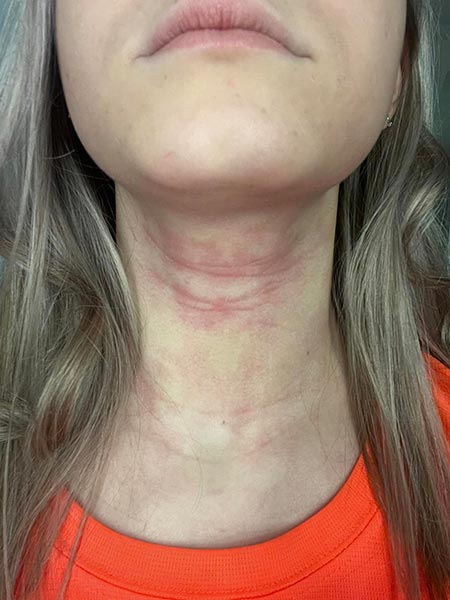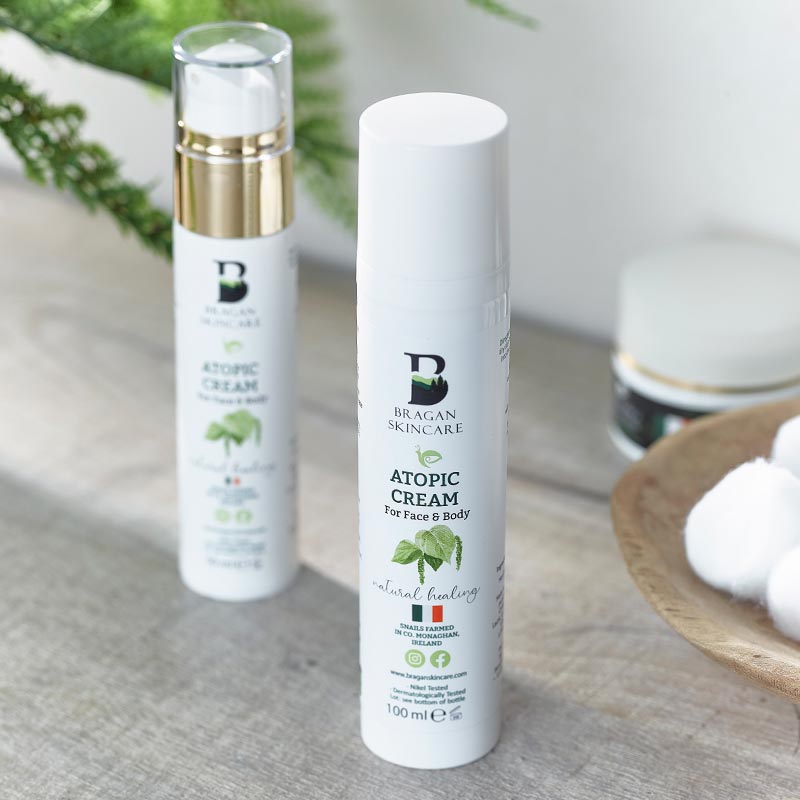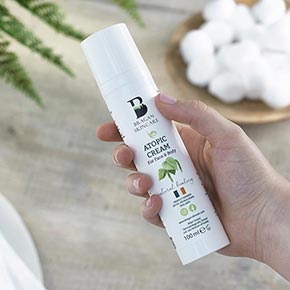Ingredients to Look For in Effective Atopic Dermatitis Treatment Creams
Managing atopic dermatitis can be overwhelming, but finding the right treatment cream is crucial. Choosing a cream with effective ingredients isn’t just about soothing itchiness; it’s about restoring and protecting your skin’s barrier. But with so many options, how do you know what to look for? This post will guide you through the key ingredients that matter most, helping you make confident choices for your skin.
Before

After onw week.

Understanding Atopic Dermatitis
Atopic dermatitis is a chronic skin condition that affects millions of people across the globe. Though it’s often associated with children, it can persist into adulthood or even develop later in life. If you’re dealing with it, you already know how challenging managing the symptoms can be. But understanding this condition is the first step towards finding relief.
What Is Atopic Dermatitis?
Atopic dermatitis, often called eczema, is a long-term inflammatory skin disorder. It causes the skin to become dry, itchy, and inflamed. This isn’t a simple rash; it occurs due to an overactive immune system reacting to triggers, such as allergens, irritants, or even stress. Those who experience it may also have asthma or hay fever, as these conditions often coexist.
The condition can improve at certain times and then flare up unexpectedly. While it’s not contagious, the visible symptoms can affect confidence and daily life.
Common Symptoms
The symptoms of atopic dermatitis can vary depending on age, skin tone, and severity. However, some of the most noticeable signs include:
- Dry, scaly skin: Skin often appears flaky or rough to the touch.
- Intense itchiness: The itch may feel unbearable, leading to constant scratching.
- Red or darker patches: On lighter skin, you may notice redness, while darker skin may appear brownish or grey.
- Thickened or cracked skin: Persistent inflammation can lead to areas of tough, thickened skin.
Since these symptoms tend to flare up and settle down, they can disrupt daily routines significantly.
How Atopic Dermatitis Affects Quality of Life
Living with atopic dermatitis can be physically uncomfortable, but its impact reaches far beyond itching and dryness. Sleepless nights due to constant scratching? Avoiding social events because of visible patches? These experiences aren’t uncommon.
The condition can affect mental health too. Many people feel self-conscious or frustrated when treatments don’t seem to work. For children, it can interfere with school and playtime. For adults, it can affect work and relationships.
This condition isn’t just a “skin problem.” It’s something that impacts both physical comfort and emotional well-being. That’s why choosing an effective atopic dermatitis treatment cream is so important. The right ingredients can help soothe immediate symptoms while protecting your skin long-term.
Key Ingredients in Atopic Dermatitis Treatment Creams

Finding the right cream for atopic dermatitis doesn’t have to be overwhelming. Certain ingredients are specifically designed to tackle the dryness, irritation, and inflammation you might be dealing with. These components aren’t just listed as a selling point—they serve an actual purpose in soothing and protecting your skin. Below, we break down the most beneficial ingredients to look for.
Moisturising Agents
Hydration is the cornerstone of managing atopic dermatitis. When your skin is dry, it’s more prone to irritation and cracking, which can worsen symptoms. This is where moisturising agents come into play. Ingredients like glycerin, hyaluronic acid, and urea are essential.
- Glycerin: Draws water into the skin, helping to keep it hydrated throughout the day.
- Hyaluronic acid: Holds up to 1,000 times its weight in water, ensuring deep hydration.
- Urea: Acts as a humectant while also gently exfoliating dry, flaky patches.
These ingredients work like a sponge, pulling moisture into the skin and locking it in. A well-hydrated skin barrier is less likely to become inflamed or itchy.
Anti-Inflammatory Ingredients
When inflammation kicks in, the redness, heat, and swelling can feel unbearable. Anti-inflammatory ingredients help calm the immune response that’s causing the flare-up. Look for colloidal oatmeal, niacinamide, or liquorice root extract in your cream.
- Colloidal oatmeal: Soothes the skin and reduces redness with its anti-inflammatory properties.
- Niacinamide: A form of vitamin B3 that helps reduce inflammation while repairing the skin barrier.
- Liquorice root extract: Contains effective compounds that help reduce irritation and redness.
Think of these ingredients as the fire extinguishers in your cream. They put out the “fire” of inflammation, providing relief and preventing further damage.
Emollients
Emollients are highly effective for skin that feels rough or scaly. These ingredients help fill the gaps between skin cells, softening and smoothing the surface. Common emollients include shea butter, petrolatum, and cetyl alcohol.
- Shea butter: Packed with natural fats that deeply condition dry, irritated skin.
- Petrolatum: Forms a protective layer that seals in moisture and prevents water loss.
- Cetyl alcohol: A fatty alcohol that smoothens the skin without causing irritation.
These ingredients are like the “glue” that binds your skin cells together, making the texture of your skin feel soft and supple again.
Barrier Repair Ingredients
Atopic dermatitis stems, in part, from a compromised skin barrier. This makes your skin vulnerable to irritants and allergens. Barrier repair ingredients help restore this shield. Look for ceramides, fatty acids, and cholesterol in your treatment cream.
- Ceramides: Strengthens the skin’s protective layer, keeping moisture in and irritants out.
- Fatty acids: Essential for repairing the skin’s natural barrier and preventing further water loss.
- Cholesterol: Supports the skin’s lipid layer, improving its resilience and elasticity.
These ingredients function as the fundamental components of a robust wall, rebuilding your skin’s defence system and safeguarding it against external stressors.
By understanding these key ingredients, you’ll be better equipped to choose an atopic dermatitis treatment cream that truly works for your skin. Each ingredient plays a distinct role, addressing hydration, inflammation, and overall skin health. With the right combination, you can take control of your symptoms and focus on comfort again.
The Role of Snail Mucin in Atopic Dermatitis Treatment
Snail mucin, also known as snail secretion filtrate, brings a surprisingly effective solution for skin-related conditions. It’s an ingredient gaining recognition not only in skincare routines but also in soothing the challenges faced by those with atopic dermatitis. Its natural composition supports hydration, skin healing, and inflammation control, making it a key ingredient worth exploring in treatment creams.
Historical Use of Snail Mucin
Snail mucin isn’t new—it’s been assisting with skincare for centuries. Ancient civilisations, including the Greeks, used snail secretions for wound care and inflammation. Farmers in Chile observed how their skin softened and healed faster after handling snails, sparking wider interest in this ingredient.
In traditional medicine, snail mucin was believed to regenerate damaged tissue and maintain youthful, healthy skin. While science has refined its application today, the premise remains the same: it’s a time-tested remedy for treating sensitive, inflamed skin.
Components of Snail Mucin: Atopic Dermatitis Treatment Cream
What makes snail mucin so effective for skin conditions? It contains a powerful combination of naturally occurring compounds, including:
- Allantoin: A soothing agent that promotes skin repair and protects against irritation.
- Glycolic acid: Gently exfoliates dead skin, enhancing cell renewal without aggravation.
- Collagen and elastin: Support skin firmness and elasticity, helping to restore your skin’s integrity.
- Hyaluronic acid: Intensely hydrates, improving moisture retention in even the driest skin.
- Antimicrobial peptides: Help fend off bacteria, reducing the risk of infection during flare-ups.
Together, these components act like a toolbox for skin repair, addressing multiple concerns at once.
Benefits of Snail Mucin for Skin Health
Snail mucin offers several advantages that directly address atopic dermatitis concerns. Each of its components plays a specific role:
- Hydration: The hyaluronic acid in snail mucin replenishes the skin barrier, locking in moisture that’s often lost during flare-ups.
- Skin repair: Allantoin and glycolic acid promote healing, making it ideal for cracked or irritated skin. These components speed up the natural regeneration process without causing further irritation.
- Anti-inflammatory action: Snail mucin helps calm redness and swelling, soothing discomfort associated with sensitive or inflamed skin.
- Protection: Antimicrobial peptides create a protective shield, reducing the chance of infection while your skin heals.
- Elasticity: Collagen and elastin help restore skin’s suppleness, tackling rough, scaly areas and promoting a smoother texture.
By combining hydration, healing, and protection, snail mucin addresses both the symptoms and causes of atopic dermatitis. It’s not just a trendy add-on—it’s an ingredient with genuine, measurable benefits for those seeking relief through an effective atopic dermatitis treatment cream.
Choosing the Right Atopic Dermatitis Treatment Cream
Selecting the best atopic dermatitis treatment cream can feel like navigating a maze. Your skin deserves care that soothes irritation while improving overall health. But with endless options and ingredient lists that read like science experiments, how do you make the right choice? Understanding how to evaluate ingredients and ensure your chosen cream works for you is essential.
Reading Product Labels: Guide on how to interpret ingredient lists when choosing a cream
When buying a treatment cream, the ingredient list is your most important resource. But let’s be honest—reading these lists can be confusing. Manufacturers often use scientific names, and some ingredients might be unnecessary or even irritating. Knowing what to look for and what to avoid can simplify decision-making.
Start by checking the active ingredients. Do they target the symptoms of atopic dermatitis, such as dryness, itching, or inflammation? Look for moisturisers like glycerin and hyaluronic acid, as well as skin-calming agents like colloidal oatmeal or niacinamide. These are proven to hydrate and soothe irritated skin.
Pay close attention to potential irritants. Fragrances, dyes, and alcohols can worsen symptoms for sensitive skin. Look for creams labelled “fragrance-free” rather than “unscented”—the latter may still contain masking agents that irritate the skin.
Here’s a quick guide to make reading labels easier:
- Top ingredients: These make up the majority of the product. If beneficial ingredients like ceramides or shea butter are listed here, it’s a good sign.
- Preservatives: Usually found at the bottom of the list, preservatives are necessary but should be gentle, like phenoxyethanol.
- Avoid “mystery” terms: Words like “proprietary blend” often lack transparency. If you’re unsure, research specific terms.
Consider the ingredient list as a window into the actual purpose of the product. It’s like the blueprint of a house—if the foundation isn’t solid, it won’t hold up under pressure.
Testing for Sensitivity: Discuss the importance of patch testing to avoid adverse reactions
Even when a cream seems perfect on paper, everyone’s skin reacts differently. Patch testing is a simple but often overlooked step to ensure your treatment cream is a match. This process can save you from worsening irritation or developing new sensitivities.
Here’s how to patch test effectively:
- Choose a small area of skin, like the inner forearm or behind your ear. These mimic the sensitivity of your facial or body skin.
- Apply a small amount of the cream and let it sit for 24-48 hours. Avoid washing or scrubbing the area during this time.
- Monitor the reaction. Look out for redness, itching, swelling, or discomfort. If these occur, the product is likely not suitable for your skin.
Why is this step so crucial? Think of it like trying on new shoes. You wouldn’t walk a mile in them without knowing they fit comfortably, right? Your skin deserves the same level of care and precaution.
Some creams labelled “hypoallergenic” or “dermatologist-tested” might still cause issues for especially reactive skin. Patch testing provides you with a sense of assurance prior to committing to full use. It’s a small investment of time that can prevent big problems later.
By reading labels carefully and taking the time to patch test, you can avoid products that cause more harm than good. An informed choice is always the best choice when it comes to managing atopic dermatitis.
Conclusion: Atopic Dermatitis Treatment Cream
Choosing the right atopic dermatitis treatment cream isn’t just about easing discomfort—it’s about long-term skin health. By focusing on ingredients that hydrate, repair, and soothe, you can manage symptoms more effectively. Each component in your cream plays a unique role, from improving moisture levels to calming inflammation and rebuilding the skin barrier.
When reviewing creams, always prioritise quality ingredients backed by research. For instance, Bragan Skincare’s Atopic Cream stands out as a trusted option. Packed with nourishing and skin-repairing ingredients, it’s tailored to alleviate dryness, irritation, and redness caused by atopic dermatitis. With its balanced formula, you’re giving your skin both immediate relief and lasting support.
Remember, the skin’s needs are unique. Test products carefully and pay attention to how your skin responds. With the right ingredients and an informed approach, you can take control of managing atopic dermatitis and restore comfort to your daily life.
Atopic Skin Repair Cream
Bragan Skincare Snail Mucin Atopic Cream At Bragan Skincare, we believe in doing things differently. Our Snail Mucin Atopic Cream isn’t just another product on the shelf—it’s a promise to your skin. Powered by the unmatched healing properties of pure snail mucin, this cream is specially crafted to soothe redness, calm irritation, and restore balance to even the most sensitive skin. Perfect for those suffering with Eczema, Psoriasis. Dermatitis and many other skin condition. Why snail mucin? Because it works. Packed with naturally occurring allantoin, glycolic acid, and peptides, it’s a game-changer for reducing redness, promoting repair, and deeply hydrating…
Featured Bragan Skincare Products
-
€39.99 – €100.00Price range: €39.99 through €100.00Select options This product has multiple variants. The options may be chosen on the product page
-
€100.00Select options This product has multiple variants. The options may be chosen on the product page


